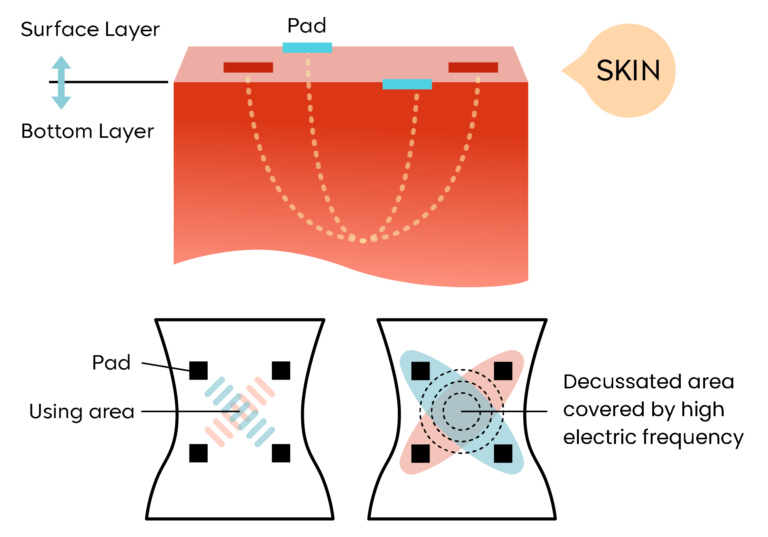Carpal Tunnel Syndrome

Using A TENS Unit For Carpal Tunnel – Is It The Best Option?
Read More
February 27, 2023
Interferential Current Therapy (ICT) is a non-invasive therapy that uses electrical muscle stimulation to relieve pain and enhance healing. It is used for a variety of conditions but especially for chronic pain and post-surgical pain. We’ll discuss everything you need to know about ICT and whether it could be an effective treatment for you.
 Interferential current therapy is a treatment modality where two medium-frequency currents are directed into damaged tissue. The frequencies are set up so that the paths of the currents cross and literally “interfere” with each other.
Interferential current therapy is a treatment modality where two medium-frequency currents are directed into damaged tissue. The frequencies are set up so that the paths of the currents cross and literally “interfere” with each other.
Since the body essentially functions using a series of electrical signals across the cells, electrical stimulation can boost the healing response of the body. ICT can promote healing by increasing the hormones and chemicals that facilitate healing.
ICT can also block pain signals as electrical stimulation can influence the nerves. This is one mechanism by which it can relieve pain, reduce swelling or edema of the damaged tissue, and promote healing of injured muscles.
How does ICT act? ICT gets delivered via electrodes. While the physics may be a bit complicated, here’s an example. If one electrode delivers at 4000 Hz and its companion at 3900 Hz, the resultant beat frequency would be 100 Hz.
Usually, the frequency required to contract muscles is between 1 and 100 Hz. Different frequencies produce different contraction responses. A larger frequency at 100 Hz can stimulate the pain gates and close them to painful impulses.
Without pain, the chemicals that respond to it and cause edema are reduced. This reduces local swelling within damaged tissues and promotes the dilation of blood vessels. The duration of each session with interferential current is somewhere between 10-20 minutes.
Here are the different frequencies used to achieve various effects:
Earlier models used two electrodes. Modern units have four electrodes that can deliver a rapid series of currents to achieve the same effect in a single sweep. They usually offer frequencies of 1-150 Hz, with a choice of up to 250 Hz or more in others.
ICT is applied with the individual in a comfortable position. Before starting, the skin is cleaned and prepped. Vacuum electrodes or pad electrodes are then placed on the area that is being treated. Two pairs of electrodes are positioned so that the crossing point of the two currents is over the treatment site. Below is a list of the estimated frequency for various tissues:
ICT works in four ways. They are listed below:
Both these pathways can provide significant pain relief. ICT can be used for joint pain, back pain, sciatica, and radicular pain.
However, if you do a sweep at 10-25 Hz, it is possible to increase blood flow, reduce edema, and stimulate the muscles.
The first mechanism is the effect of muscle contraction, where ICT contracts the muscles which cause the blood supply to increase in response to the metabolic demand of the muscle. The other mechanism is the effect on the sympathetic nerves which causes the vessels to dilate.
The role of the sympathetic nervous system is to increase blood supply via vasodilation. ICT stimulates the sympathetic nerves, increasing blood flow. At present, the 10-20 or 10-25Hz frequency sweep has the desired effect of increasing blood supply.
Interferential current is different from TENS (transcutaneous electrical nerve stimulation). Firstly, interferential current modulates at a much higher frequency at about 4000 Hz compared to TENS at 125 Hz.
At higher frequencies, the resistance of the skin decreases, so there is a better penetration depth and larger volume of tissue treated. As a result, interferential current therapy can relieve deep seated pain within the tissues as well. ICT also improves circulation which facilitates healing, something that is not possible with TENS.
ICT can be used for various clinical conditions that cause chronic pain. Here are some of the clinical conditions in different areas of the body that can be targeted with interferential current therapy:
ICT can be used in the neck to treat conditions such as cervical spondylosis, disc herniation, and spinal canal stenosis. All of these conditions can cause severe and chronic pain that is often not relieved with analgesic medications. ICT can suppress pain and block nerve conduction so the perception of pain in the neck is less.
Disc herniation and spinal canal stenosis are chronic conditions that affect the spine and the back, leading to back pain. Chronic lower back pain that arises due to a nerve impingement, degenerative disc disease, or a herniated disc can also be treated with ICT.
Osteoarthritis and rheumatoid arthritis are conditions that can affect the knee. Interferential current therapy can be used to treat the pain and also reduce the edema surrounding the affected knee joint.
Conditions such as a frozen shoulder can be treated with multiple sessions of ICT. If there is an injury to a muscle or ligament in the shoulder, ICT can also effectively treat these conditions as well.
Pain from nerve conditions such as peripheral neuropathy, neuralgia, or post-herpetic lesions, can also be treated with interferential current therapy.
While ICT is effective, there are some potential side effects, especially if an individual is new to interferential current therapy. Not everyone may experience these side effects but they are a possibility. Some of the side effects of ICT are listed below:
Interferential current therapy is mostly safe and without any major side effects. However, there are certain individuals for whom it is not recommended:
You don’t have to put up with pain – it is possible to live a pain-free life. Relatyv offers ICT as a non-pharmaceutical, non-opioid, non-drug, nonsurgical, non-invasive, and non-chiropractic treatment for pain.
If your doctor has not offered interferential current therapy for your pain, then it may be time to ask about your treatment options.
About the Author
Will is a healthcare executive, innovator, entrepreneur, inventor, and writer with a wide range of experience in the medical field. Will has multiple degrees in a wide range of subjects that give depth to his capability as an entrepreneur and capacity to operate as an innovative healthcare executive.
Share on Social Media




You can see how this popup was set up in our step-by-step guide: https://wppopupmaker.com/guides/auto-opening-announcement-popups/
You can see how this popup was set up in our step-by-step guide: https://wppopupmaker.com/guides/auto-opening-announcement-popups/
Neurofunctional Pain Management Overview
Symptoms
Conditions Treated
Treatments
Articles by Category
Locations
Colorado
Wisconsin
Georgia
Hiram
Lawrenceville
Marietta
Powder Springs
Texas
Waco
Victoria
Illinois
Buffalo Grove
New Lenox
St. Charles
Arizona
Tucson
Waddell
Arlington
Avondale
Buckeye
Superior
Mesa
Palo Verde
Morristown
Tempe
Chandler
Anthem
Eloy
Florence
Fort McDowell
Phoenix
El Mirage
Coolidge
Gilbert
Arizona City
Casa Grande
Casa Blanca
Aguila
Sacaton
Apache Junction
Kearny
Stanfield
Goodyear
Litchfield Park
Alabama
Arkansas
California
Florida
Idaho
Indiana
Iowa
Kansas
Louisiana
Maryland
Michigan
Rhode Island
Minnesota
Mississippi
Nevada
New Jersey
New Mexico
North Carolina
Ohio
Pennsylvania
South Dakota
Tennessee
Utah
Virginia
Washington

